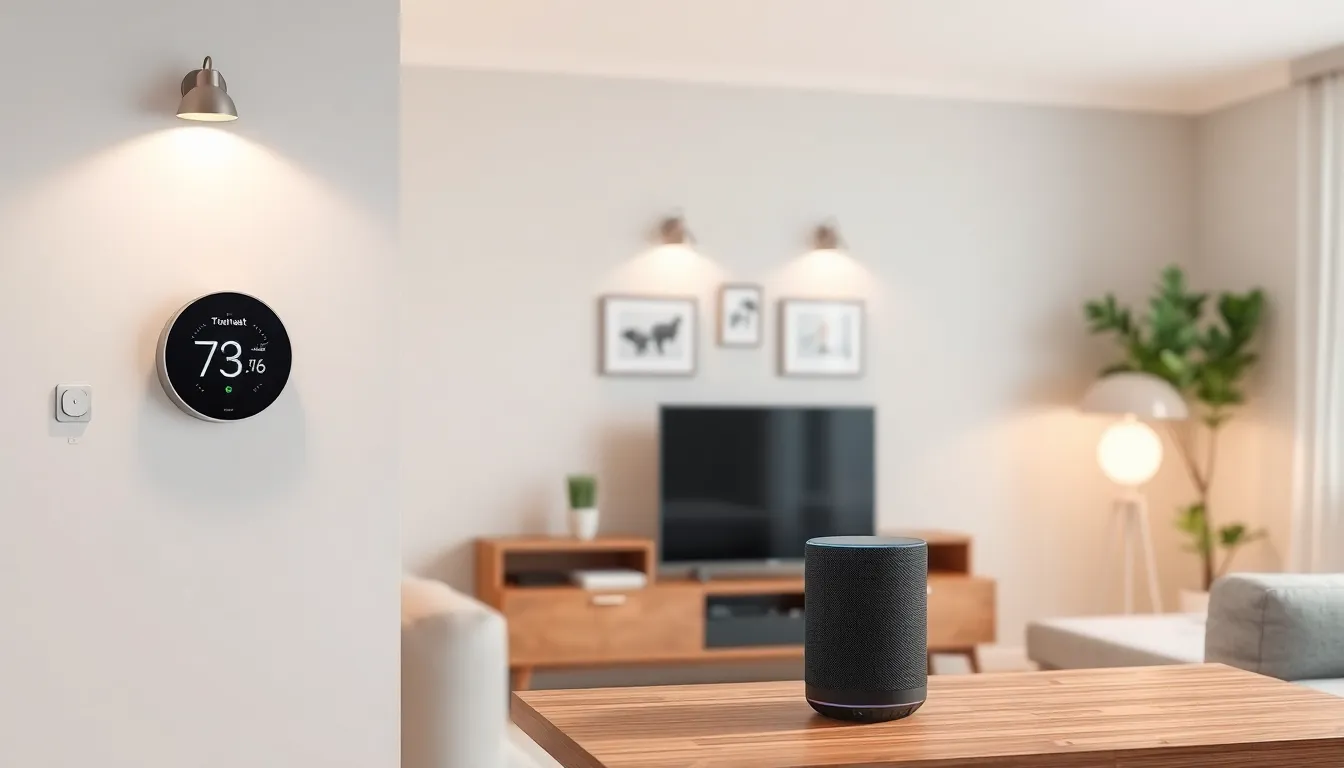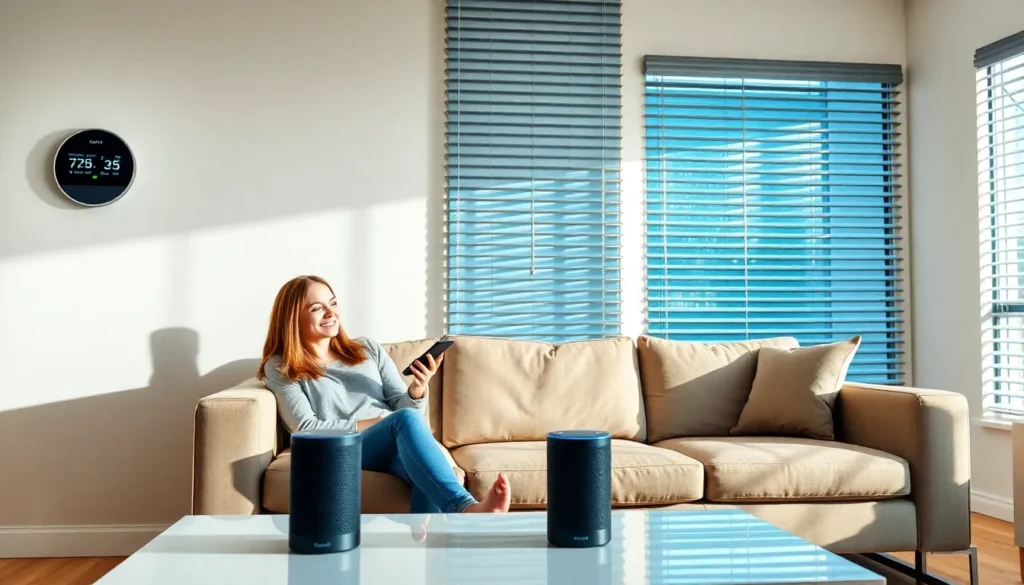Table of Contents
ToggleHome automation isn’t just for tech enthusiasts anymore; it’s quickly becoming a staple in modern living. Imagine waking up to the aroma of freshly brewed coffee, with the blinds automatically lifting to let the sunshine in—all without lifting a finger. Sounds dreamy, right? With the latest advancements in smart technology, homes are becoming smarter, more efficient, and a little bit lazier, but in a good way!
Latest Trends in Home Automation News
Smart home technology evolves rapidly, introducing new capabilities each year. Increased integration with artificial intelligence enhances user experiences significantly. Voice control systems, such as Amazon Alexa and Google Assistant, dominate the market, simplifying interactions with devices.
Energy efficiency becomes a focal point for many homeowners, leading to the adoption of smart thermostats, smart lighting, and energy monitoring devices. These products optimize energy consumption and reduce utility bills.
IoT devices gain popularity, allowing seamless communication between appliances. Security camera systems, smart locks, and motion sensors work together to provide comprehensive safety solutions. Homeowners increasingly see value in systems that offer remote monitoring and alerts.
In addition, homeowners embrace home health technology, including air quality monitors and smart sleep devices. These gadgets offer insights into living conditions and promote healthier lifestyles. Integration with fitness trackers enhances this trend, allowing for a holistic approach to wellness.
Subscription services for smart home products expand availability, allowing users to access the latest gadgets without significant upfront investments. Many companies now offer innovative financing options or leasing arrangements that appeal to a wider audience.
Sustainable products also make waves in the market. Solar panels, smart irrigation systems, and energy-efficient appliances address environmental concerns while reducing costs.
Local ordinances and incentives further boost the adoption of home automation technologies. Homeowners find themselves drawn to environmentally friendly solutions that contribute to energy savings and lower carbon footprints.
Innovative Technologies Shaping the Future

Innovative technologies are redefining home automation, bringing efficiency and convenience to everyday living. With advancements in smart devices, automation has reached new heights.
Smart Home Devices
Smart home devices have transformed how people interact with their living spaces. Thermostats adjust heating and cooling based on usage patterns, ensuring energy conservation. Lighting systems change according to the time of day or occupancy, enhancing user comfort and security. Smart locks allow remote access, providing peace of mind for homeowners. Appliances like refrigerators and washing machines connect to the internet, allowing monitoring and control from anywhere. These devices offer seamless communication, creating an interconnected environment that simplifies daily tasks.
AI and Machine Learning Integration
Integration of AI and machine learning enhances the functionality of home automation. Systems learn from user behavior, optimizing settings to match individual preferences. Voice-activated assistants respond to commands, allowing hands-free control over various devices. Predictive analytics help identify energy consumption trends, enabling proactive adjustments that save money. Smart cameras distinguish between people and pets, reducing false alarms in security systems. Enhanced interaction between devices improves overall home intelligence, creating personalized experiences tailored to each homeowner’s lifestyle.
Market Insights and Analysis
Home automation continues to expand rapidly. Increased consumer interest and technological advancements drive this growth.
Industry Growth and Projections
The home automation market is expected to reach $174 billion by 2025, reflecting a compound annual growth rate of 26%. Demand for smart devices contributes to this increase, with energy efficiency and convenience being primary motivators for consumers. Rapid advancements in AI and machine learning capabilities enhance device functionality. Furthermore, the rise of IoT devices allows seamless communication between numerous systems, creating entirely automated homes. Companies are focusing on developing user-friendly interfaces to attract broader audiences. Increased investment from various sectors indicates strong confidence in the market’s future potential.
Key Players in the Home Automation Space
Significant companies shape the home automation landscape. Google Nest leads in smart thermostats and home security devices. Amazon, through its Alexa ecosystem, provides extensive device compatibility and integration. Samsung SmartThings offers an open platform that connects numerous third-party devices. Other major players include Philips Hue, known for lighting solutions, and Ring, specializing in security technology. Smaller startups continue to innovate and introduce niche products, driving competition within the industry. Partnerships between tech firms and manufacturers enhance product offerings and help bring cutting-edge solutions to consumers. Increased collaboration reflects the growing importance of interoperability in home automation systems.
Consumer Engagement and Feedback
Consumer engagement plays a crucial role in shaping the home automation market. Feedback from users directly influences product development and improvements.
Popular Products and Reviews
Smart thermostats lead the popularity list among home automation devices. Consumers frequently praise models like the Nest Learning Thermostat for their ease of use and energy savings. Smart speakers, including Amazon Echo, garner positive reviews for their voice control features and smart home integration capabilities. Additional products, such as Ring Video Doorbell, receive high ratings for enhancing home security through user-friendly video monitoring. Reviews demonstrate that consumers seek devices that offer both functionality and reliability.
User Experience and Satisfaction
User experience significantly impacts satisfaction levels in home automation. Customers who’ve integrated smart devices report enhanced convenience in daily routines. Those utilizing automated lighting often mention improved ambiance and energy efficiency. Positive experiences with customer support further increase loyalty to brands like Google Nest. Industry surveys consistently indicate high user satisfaction when devices are easy to set up and operate. Feedback often highlights the importance of seamless connectivity and intuitive interfaces, essential for a positive home automation experience.
Regulatory and Security Considerations
Compliance with regulations is crucial in home automation. Various standards exist to ensure the safety and reliability of smart devices. The Federal Trade Commission (FTC) enforces laws regarding data privacy and security, holding manufacturers accountable for protecting user information.
Privacy concerns significantly impact consumer trust. Cybersecurity threats are prevalent, and breaches can compromise personal data. Manufacturers implement encryption protocols, secure authentication methods, and regular software updates to mitigate risks. According to a survey by the Pew Research Center, approximately 62% of consumers express concerns about data privacy in smart home devices.
OEMs (original equipment manufacturers) play a role in security features. They often adhere to certifications like UL (Underwriters Laboratories) and ISO (International Organization for Standardization), signaling compliance with stringent safety requirements. Smart devices that lack these certifications may be more susceptible to hacking and user data leaks.
Local laws may also impose restrictions on installation and usage. Homeowners should consider zoning regulations that pertain to surveillance devices. Additionally, homeowners associations (HOAs) might have guidelines governing the types of smart technology permissible.
Future advancements in home automation will likely focus on regulatory adaptation. As technology evolves, so do the legal frameworks governing it. Consumer education continues to be a priority, equipping users to make informed decisions while navigating the complex landscape of smart home devices.
Manufacturers’ commitment to robust security measures enhances user confidence. Products with industry endorsements signal reliability, fostering a sense of security in ever-connected environments.
The future of home automation looks promising as technology continues to advance and integrate into everyday life. Homeowners are increasingly embracing smart solutions that enhance convenience and efficiency while prioritizing energy savings and security. With major players leading the charge and consumer feedback driving innovation, the market is set to expand significantly in the coming years.
As the industry evolves, regulatory and security considerations will remain crucial. By prioritizing user privacy and adhering to safety standards, manufacturers can build trust and confidence among consumers. The ongoing development in home automation not only transforms living spaces but also paves the way for a smarter, more sustainable future.






